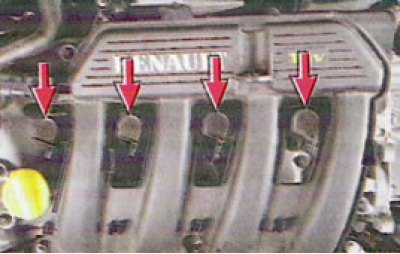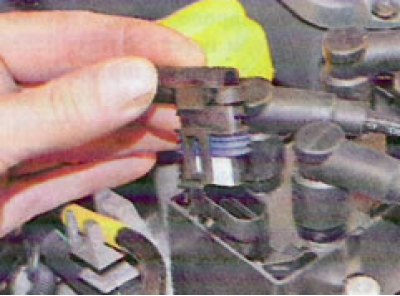Compression (pressure at the end of the compression stroke) in cylinders - the most important diagnosable indicator of the engine, carried out without disassembling it. By its average value and by the difference in values in individual cylinders, it is possible to determine with a sufficient degree of accuracy the degree of general wear of engine SHPG parts and to identify malfunctions of this group and valve mechanism parts.
To check, use a compression gauge, which can be purchased at parts stores. There are compression gauges on sale, both threaded, in which a threaded fitting is installed to screw the spark plug into place, and with a rubber tip, which simply press strongly against the spark plug hole.
The conditions for the correctness of the readings during the compression test are the serviceability of the starter and the full charge of the battery.
The procedure for checking compression in the cylinders is shown on the example of the K7M engine. Check the compression of the K4M engine in the same way.

The difference lies in the fact that four ignition coils must first be removed from the K4M engine spark plugs.
1. Start the engine and warm it up to operating temperature.

2. Stop the engine, disconnect the low voltage wire harness connector from the ignition module.
Cranking the engine with a starter with the tips of the high-voltage wires disconnected and the ignition module not disconnected can lead to a breakdown of its high-voltage circuit.

3. Turn out all candles.

4. Turn off the fuel pump by removing its relay in the mounting block installed in the engine compartment of the car.

5. Screw a compression gauge into the spark plug hole of the cylinder being checked.
6. Fully depress the accelerator pedal to fully open the throttle.
7. Turn on the starter and turn the engine crankshaft with it until. until the pressure in the cylinder stops increasing. This corresponds to about four compression strokes.
To obtain a correct compression gauge reading, the crankshaft must rotate at 180-200 min' or higher, but no more than 350 min'.
8. After writing down the readings of the compression gauge, set its arrow to zero. (Readings can be reset in various ways, depending on the design of the instrument).
9. Repeat steps 5-8 for the rest of the cylinders. The pressure should not be lower than 1.0 MPa and should not differ in different cylinders by more than 0.1 MPa. Reduced compression in individual cylinders can result from loose valves in the seats, damaged cylinder head gaskets, broken or burned piston rings. Low compression in all cylinders indicates worn piston rings.
10. To find out the causes of insufficient compression, pour about 20 ml of clean engine oil into the cylinder with reduced compression and measure the compression again. If the readings of the compression gauge have increased, the most likely malfunction of the piston rings. If the compression value remains unchanged, then this indicates a loose fit of the valve plates to their seats or damage to the cylinder head gasket.
The cause of insufficient compression can also be found out by supplying compressed air to the cylinder in which the piston is previously set to TDC of the compression stroke. To do this, remove the tip from the compression gauge and attach the compressor hose to it. Insert the tip into the spark plug hole and inject air into the cylinder at a pressure of 0.2-0.3 MPa. To prevent the engine crankshaft from turning, engage a higher gear and brake the vehicle with the parking brake. Exit (a leak) air through the throttle assembly indicates a leak in the intake valve, and through the muffler - a leak in the exhaust valve. If the cylinder head gasket is damaged, air will escape through the expansion tank neck in the form of bubbles or into an adjacent cylinder, which is detected by a characteristic hissing sound.
